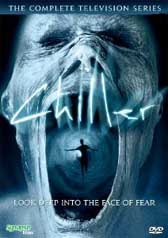 CHILLER:
THE COMPLETE TELEVISION SERIES (1995)
CHILLER:
THE COMPLETE TELEVISION SERIES (1995)Directors: Bob Mahoney, Lawrence Gordon Clark, and Rob Walker
Synapse Films
 CHILLER:
THE COMPLETE TELEVISION SERIES (1995)
CHILLER:
THE COMPLETE TELEVISION SERIES (1995)Following THE HAMMER HOUSE OF HORROR, Synapse Films have delved into the ITV archives again for more made-for-TV chills with the nineties Yorkshire Television series CHILLER.

The series starts off with “Prophecy” (52:52) in which Francesca (Sophie Ward, YOUNG SHERLOCK HOLMES) allows her drunken friends into the old cellar beneath her father’s pizza parlor to for a little Ouija. Her friend Susie (Samantha Holland) appears to make contact with a ghost who cryptically spells out their prophecies. We then jump forward several years with Francesca studying archaeology in college while her friends have all moved on with their lives when the deadly prophecies start coming true. Meanwhile, Francesca has met widowed aristocrat Oliver (Nigel Havers, CHARIOTS OF FIRE) whose family’s closet of skeletons includes a Gilles de Rais-esque ancestor whose acts forced the family to set up house (or manor) away from London and, more recently, an emotionally-damaged son Edward (Tom Piccin) who keeps a log of all freak deaths – ostensibly as a means of dealing with his mother’s death years before – that includes the latest misfortunes of Francesca’s friends. Edward believes the visions of these deaths come to him through his ancestor, who Francesca has been released through the Ouija game.
 Director
Lawrence Gordon Clark had previously helmed seven of the eight BBC “Ghost
Stories for Christmas” specials (five M.R. James’ adaptations, one
from Dickens, and one original scenario) with chilling results, but “Prophecy”
is a potentially effective (if unoriginal) but ultimately muddled premise overstuffed
with underdeveloped victim characters to goose the main story with commercial
fade-out timed freak death scenes (which of course conform to TV standards).
This comes as no surprise, as the episode is actually an adaptation of a 300+
page novel by mystery novelist Peter James. The adaptation was undertaken by
Stephen Gallagher, who had previously adapted his own 1990 novel for Clark’s
1991 three-hour miniseries CHIMERA (which was condensed to 100 minutes and released
here stateside as a direct-to-video feature MONKEY BOY), and one assumes that
this may have started life as a similar multi-part miniseries hastily reworked
into a fifty-minute episode of an anthology series (and it might have worked
had it dispensed with most of the victims, including an exorcist played by Tony
Haygarth [Renfield in the Frank Langella version of DRACULA]). Francesca’s
circle of friends are barely introduced (some do not even get a close-up or
are introduced by name until their later death scenes) and we only hear learn
two of the prophecy clues (I would really like to have been privy to the single
word prophecy that means “shot in Washington D.C. by a guy in a Utah Jazz
cap”). Ward is uninvolving as a rather passive protagonist Clark has always
had a knack finding for neat locations for his films, and the episode’s
most involving cinematographic moments are in the camera’s exploration
of the ins-and-outs of Oliver’s Elizabethan country estate. There is no
credit for the incidental music, but the title music is credited to Colin Towns
(who did a much more effective job on FULL CIRCLE/THE HAUNTING OF JULIA).
Director
Lawrence Gordon Clark had previously helmed seven of the eight BBC “Ghost
Stories for Christmas” specials (five M.R. James’ adaptations, one
from Dickens, and one original scenario) with chilling results, but “Prophecy”
is a potentially effective (if unoriginal) but ultimately muddled premise overstuffed
with underdeveloped victim characters to goose the main story with commercial
fade-out timed freak death scenes (which of course conform to TV standards).
This comes as no surprise, as the episode is actually an adaptation of a 300+
page novel by mystery novelist Peter James. The adaptation was undertaken by
Stephen Gallagher, who had previously adapted his own 1990 novel for Clark’s
1991 three-hour miniseries CHIMERA (which was condensed to 100 minutes and released
here stateside as a direct-to-video feature MONKEY BOY), and one assumes that
this may have started life as a similar multi-part miniseries hastily reworked
into a fifty-minute episode of an anthology series (and it might have worked
had it dispensed with most of the victims, including an exorcist played by Tony
Haygarth [Renfield in the Frank Langella version of DRACULA]). Francesca’s
circle of friends are barely introduced (some do not even get a close-up or
are introduced by name until their later death scenes) and we only hear learn
two of the prophecy clues (I would really like to have been privy to the single
word prophecy that means “shot in Washington D.C. by a guy in a Utah Jazz
cap”). Ward is uninvolving as a rather passive protagonist Clark has always
had a knack finding for neat locations for his films, and the episode’s
most involving cinematographic moments are in the camera’s exploration
of the ins-and-outs of Oliver’s Elizabethan country estate. There is no
credit for the incidental music, but the title music is credited to Colin Towns
(who did a much more effective job on FULL CIRCLE/THE HAUNTING OF JULIA).

Next up is the series is “Toby” (52:12) in which Ray (Martin Clunes, TV’s MEN BEHAVING BADLY, [the original British version]) and Louise (Serena Gordon, GOLDENEYE) move into a creepy old house after she loses their unborn child in a car accident. Not only has Louise brought plenty of reminders of unborn Toby to the new house, but there’s also an upstairs nursery with a twinkling mobile left behind by the previous owners whose children – cat-loving neighbor Mrs. Leslie (Rosemary Leach, A ROOM WITH A VIEW) tells us – were absolute monsters. Louise is overjoyed to find herself pregnant again so soon, but sonogram equipment reveals nothing in her growing womb despite the kicking she and her husband can both feel. She goes into labor on the very day that Toby was supposed to be born but births nothing and it is ruled a hysterical pregnancy brought on by feelings of guilt. Louise, however, is not so sure when she starts hearing the cries of a child in the nursery and the cradle begins to rock itself. Mrs. Leslie’s psychic friend Mr. Canfield (Ralph Nossek, BRAZIL) tells her that “Toby” doesn’t just want attention, he wants revenge on the person who hurt him (his mother). Ray thinks she needs psychological help but Louise endeavors to ignore the cries until she becomes pregnant again (this time for real) and “Toby” starts getting aggressive and abusive.
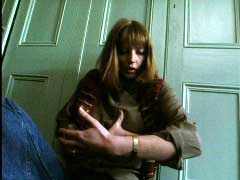 The
sounds of Toby’s baby laughter and the sight of an invisible entity trying
to nurse from a woman would make this episode pretty laughable if not for Gordon’s
sympathetic portrayal (Clunes is only good when he’s unsympathetic so
he just flounders here in a scenario which could have afforded to show us how
he’s dealing with both the loss and his wife’s sanity issues). Prowling
cats, sound design full of baby’s cries and whale song, and a couple well-executed
visual effects seem to be building up to a more overtly horrific climax, but
ultimately goes for a more predictably yet dramatically-resonant finale (with
the usual surprise ending minus the hysterics). Director Bob Mahoney also helmed
the episode “The Man Who Did Not Believe in Ghosts” (see below)
while scripter Glenn Chandler has authored over a hundred episodes of the twenty-seven
season crime series TAGGART.
The
sounds of Toby’s baby laughter and the sight of an invisible entity trying
to nurse from a woman would make this episode pretty laughable if not for Gordon’s
sympathetic portrayal (Clunes is only good when he’s unsympathetic so
he just flounders here in a scenario which could have afforded to show us how
he’s dealing with both the loss and his wife’s sanity issues). Prowling
cats, sound design full of baby’s cries and whale song, and a couple well-executed
visual effects seem to be building up to a more overtly horrific climax, but
ultimately goes for a more predictably yet dramatically-resonant finale (with
the usual surprise ending minus the hysterics). Director Bob Mahoney also helmed
the episode “The Man Who Did Not Believe in Ghosts” (see below)
while scripter Glenn Chandler has authored over a hundred episodes of the twenty-seven
season crime series TAGGART.
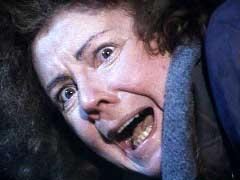
Disc one closes with “Here Comes the Mirror Man” (52:42) – also directed by Lawrence Gordon Clark and also scripted by Stephen Gallagher from his radio play “The Kingston File” – in which young Gary Kingston (John Simm, TV’s DOCTOR WHO) prefers living in a derelict cathedral where he works as caretaker to a room at the hostel arranged by social worker Wendy (Anna Keaveney, VERA DRAKE). Her concern for Gary’s well-being does not go over well with Michael (Paul Reynolds, CASTAWAY) – a young man who may be actually be a demon, or simply a figment of Gary’s imagination (or both) – so Gary pushes her in front of a truck. Because of budget cuts, all of Wendy’s open cases are split among the rest of the office staff; and Gary’s file ends up with harried Anna (Phyllis Logan, THE ANGRY EARTH) who is ready to close the case when she visits the cathedral and Gary claims to be someone else and does not know the whereabouts of her client. When an infant from another one of her cases winds up in the hospital, Anna is suspended pending a department review and decides to focus on Gary’s case outside of work at the expense of her almost non-existent personal life. Tormented Gary is resolved to keep his distance from Anna, but Michael knows that Gary is already fixated on her and orders him to kill her (lest Gary be institutionalized and Michael leave him to find someone else to inhabit).
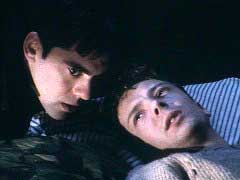 “Here
Comes the Mirror Man” is smaller in scope than Clark’s and Gallagher’s
“Prophecy” but the episode also feels like a longer project drastically
condensed to under an hour. Clark gets a lot of mileage out of Reynold’s
discomforting stares as well as close two-shots that contrast Michael’s
steady inexpressiveness and Gary’s face shifting between anger and torment;
but the dynamics of their relationship are under-explored (similarly, the turbulent
subplot relationship between Anna and her detective boyfriend [Mark Arden] is
similarly underdeveloped). A lot more is stated than actually conveyed such
as how the job of social worker wears on the psyches of Anna and her co-workers
(whose parts seem to have been pruned down). We have to take it at face value
that Anna would throw herself into Gary’s case over the stress of her
suspension and her personal life because the episode’s duration does not
seem to allow for an effective portrayal of Anna’s deterioration (which
makes the surprise ending seem all the more cheap) since it also has to fit
in two more victims – necking couple who think the cathedral is an ideal
creepy spot in which to bunk down – who then figure into the climax. Gallagher
decides to go with the “damsel in distress” ending rather than something
darker. Once again, though, Clark has a great eye for locations, and the condemned
gothic cathedral is exploited visually for all it’s worth.
“Here
Comes the Mirror Man” is smaller in scope than Clark’s and Gallagher’s
“Prophecy” but the episode also feels like a longer project drastically
condensed to under an hour. Clark gets a lot of mileage out of Reynold’s
discomforting stares as well as close two-shots that contrast Michael’s
steady inexpressiveness and Gary’s face shifting between anger and torment;
but the dynamics of their relationship are under-explored (similarly, the turbulent
subplot relationship between Anna and her detective boyfriend [Mark Arden] is
similarly underdeveloped). A lot more is stated than actually conveyed such
as how the job of social worker wears on the psyches of Anna and her co-workers
(whose parts seem to have been pruned down). We have to take it at face value
that Anna would throw herself into Gary’s case over the stress of her
suspension and her personal life because the episode’s duration does not
seem to allow for an effective portrayal of Anna’s deterioration (which
makes the surprise ending seem all the more cheap) since it also has to fit
in two more victims – necking couple who think the cathedral is an ideal
creepy spot in which to bunk down – who then figure into the climax. Gallagher
decides to go with the “damsel in distress” ending rather than something
darker. Once again, though, Clark has a great eye for locations, and the condemned
gothic cathedral is exploited visually for all it’s worth.
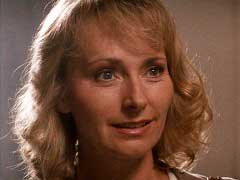
Disc two opens with the fourth episode “The Man Who Didn’t Believe in Ghosts” (52:54), which takes us back into traditional ghost story territory (or so it seems). When professional paranormal debunker Richard Cramer (Peter Egan, DEATH AT A FUNERAL) suffers a stroke, he and his family move to the countryside and purchase supposedly-haunted Windwhistle Hall from its former owner Peter Walker (Miles Anderson, TOMORROW NEVER DIES) who now works in the village doing odd jobs. Right away, Cramer’s son Matthew (Tobias Saunders) starts seeing a wandering female specter and his dog disappears. His wife Sophie (Mel Martin, WHITE HUNTER BLACK HEART) is nearly killed twice in strange accidents. Cramer’s work is suffering from the family strain but he seems more worried about his professional reputation (the idea of a debunker of the paranormal fleeing a haunted house) than any threats against his family, and he instead looks to the house’s more recent past: the suspicious accidental death of Walker’s heiress wife (Helen Caldwell, THE CRYING GAME).
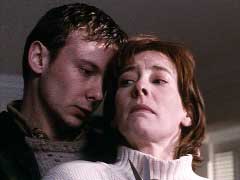 Despite
a great location, “The Man Who Didn’t Believe in Ghosts” –
helmed once again by Bob Mahoney – feels more like a Lifetime-esque melodrama
with supernatural and mystery elements (and a script which can’t decide
whether it wants to be a whodunit or a ghost story, and then just picks one
resolution randomly before throwing in a hint of the other for the usual surprise
ending). The scares are met with the usual under-reaction by the characters
in the necessity of keeping them staying on in the house, even when the logical
explanations are ridiculous (when fresh maggots suddenly appear on a turkey
that has been in the oven for hours, all Cramer can say is “I’m
going to kill that butcher!”); yet it becomes far too obvious what’s
really going on in spite of seeming objective visual confirmations of the opposite.
This episode may also have been pruned for running time or scenes thrown out
of the script in favor later scenes that tell us what we should have been shown
(Cramer drinking more as his work suffers and a supposed change in his behavior,
although he seems to be rather arrogant and rude throughout). Although not completely
awful, it’s certainly the least satisfying episode.
Despite
a great location, “The Man Who Didn’t Believe in Ghosts” –
helmed once again by Bob Mahoney – feels more like a Lifetime-esque melodrama
with supernatural and mystery elements (and a script which can’t decide
whether it wants to be a whodunit or a ghost story, and then just picks one
resolution randomly before throwing in a hint of the other for the usual surprise
ending). The scares are met with the usual under-reaction by the characters
in the necessity of keeping them staying on in the house, even when the logical
explanations are ridiculous (when fresh maggots suddenly appear on a turkey
that has been in the oven for hours, all Cramer can say is “I’m
going to kill that butcher!”); yet it becomes far too obvious what’s
really going on in spite of seeming objective visual confirmations of the opposite.
This episode may also have been pruned for running time or scenes thrown out
of the script in favor later scenes that tell us what we should have been shown
(Cramer drinking more as his work suffers and a supposed change in his behavior,
although he seems to be rather arrogant and rude throughout). Although not completely
awful, it’s certainly the least satisfying episode.

The final episode “Number Six” (53:12) is the best of the series. For the past two years, a small English village has been besieged by the murders of five children. Each one happens during the full moon, and each body is discovered under an oak tree. With the next full moon a few hours away, the schools, the police, and the parents are all taking the usual precautions to make sure kids get to school and get picked up without ever losing sight of them. Inspector Jack Taylor (Kevin McNally, SLIDING DOORS) is leading the investigation without much progress, and is too busy to realize that his own kid Johnny (Patrick McGuire) may be the next victim since the kid is receiving visitations from the now apparently evil specters of his classmates. The only obvious suspect is the owner of a sweets shop (Barrie Houghton, INSEMINOID) who did his time for “interfering with a child” a decade before, but plumber Mr. Keegan (John McEnery, THE DUELLISTS) carries a butcher knife in his toolbox, his wife (Barbara Ewing, DRACULA HAS RISEN FROM THE GRAVE) hears the voices of the ghost children, and lovely schoolteacher Emma (Maggie O'Neill, GORILLAS IN THE MIST) has discovered that the local school was built over a Druidic site (and Celtic words have crept into the school children’s local variation on “Eeny, Meeny, Miny, Moe”).
 While
some of the other episodes felt like drastically shortened scripts of feature-length
or longer projects, “Number Six” feels almost like something that
was cut down after it had been shot with underdeveloped relationships, characters
not properly introduced but of seeming importance to the plot or other interesting
characters whose parts seem to have been trimmed down to the bits most relevant
to the plot even though there are hints in the existing scenes that they might
have had more scenes that were not used (for instance, the child psychologist
[Don Warrington, 8 ½ WOMEN] and his daughter, and a sleazy real estate
agent with a scar on his face). The village setting is atmospheric but not sufficiently
explored visually and the central triangular relationship between the schoolteacher,
the detective, and his ex (Lorraine Ashbourne, KING KONG) doesn’t play
as much into the climax as one expects. The story wants us to follow the thriller
aspect even as it drops in more and more elements of the supernatural, and you
might not recognize the killer when revealed because that character is not visually
linked to one of the central clues (itself not emphasized enough early on in
the children’s drawings where it first shows up) and seems an almost random
selection. This episode has enough characters, subplots, and settings to have
made a nice feature (or at least a made-for-TV one) or miniseries and one can’t
help but feel that it might have been more. Director Rob Walker has moved from
British TV to direct-to-video titles like GOTHIC VAMPIRES FROM HELL, and writer
Anthony Horowitz’s other TV thrillers have included THE MIDSOMER MURDERS
and adaptations for AGATHA CHRISTIE’S POIROT.
While
some of the other episodes felt like drastically shortened scripts of feature-length
or longer projects, “Number Six” feels almost like something that
was cut down after it had been shot with underdeveloped relationships, characters
not properly introduced but of seeming importance to the plot or other interesting
characters whose parts seem to have been trimmed down to the bits most relevant
to the plot even though there are hints in the existing scenes that they might
have had more scenes that were not used (for instance, the child psychologist
[Don Warrington, 8 ½ WOMEN] and his daughter, and a sleazy real estate
agent with a scar on his face). The village setting is atmospheric but not sufficiently
explored visually and the central triangular relationship between the schoolteacher,
the detective, and his ex (Lorraine Ashbourne, KING KONG) doesn’t play
as much into the climax as one expects. The story wants us to follow the thriller
aspect even as it drops in more and more elements of the supernatural, and you
might not recognize the killer when revealed because that character is not visually
linked to one of the central clues (itself not emphasized enough early on in
the children’s drawings where it first shows up) and seems an almost random
selection. This episode has enough characters, subplots, and settings to have
made a nice feature (or at least a made-for-TV one) or miniseries and one can’t
help but feel that it might have been more. Director Rob Walker has moved from
British TV to direct-to-video titles like GOTHIC VAMPIRES FROM HELL, and writer
Anthony Horowitz’s other TV thrillers have included THE MIDSOMER MURDERS
and adaptations for AGATHA CHRISTIE’S POIROT.
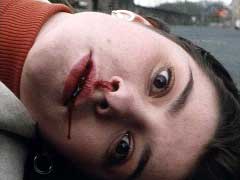 When
Synapse released their recent R1 set of HAMMER HOUSE OF HORROR, they converted
the PAL masters to progressive 23.976 and adjusted the pitch to make up for
the slower frame rate (which added about two minutes to each episode’s
original 25 fps running time). CHILLER has also been converted to progressive
23.976; however, there has been no effect on the running time (when comparing
the episode timings here to the BBFC listings for each separate episode). Since
motion does not seem adversely effected (some jittery movements seem to have
more to do with the rushed shooting and handheld cameras), I’m guessing
Synapse may have availed themselves of some new conversion software/hardware
not unlike the Alchemist used to convert SD TV projects between PAL and NTSC
formats with advanced motion estimation. The productions were apparently shot
on film and then finished on video, but the moody hazier look of these productions
– compared to the aforementioned HAMMER HOUSE OF HORROR episodes –
does not translate as well into the digital format. The image should look fine
on older CRT televisions and smaller HD displays, but it was transferred from
film to SD (likely 1”) PAL video so it has the over-sharpened edges, fair
detail, and crepe-paper texture seen in digitized tape masters (macro blocking
is evident during a fiery explosion in the first episode, but that may be a
part of the initial digitization than a DVD encoding fault). The Dolby Digital
2.0 mono audio is fine throughout. There are absolutely no extras (interviews
with Lawrence Gordon Clark might have been nice since he provided seven this
year for BFI’s GHOST STORIES FOR CHRISTMAS set). Although CHILLER isn’t
that great a series, let’s hope Synapse looks into some other British
TV genre series. As with all titles licensed from ITV by various labels, Synapse’s
CHILLER is coded for Region 1 playback only. (Eric
Cotenas)
When
Synapse released their recent R1 set of HAMMER HOUSE OF HORROR, they converted
the PAL masters to progressive 23.976 and adjusted the pitch to make up for
the slower frame rate (which added about two minutes to each episode’s
original 25 fps running time). CHILLER has also been converted to progressive
23.976; however, there has been no effect on the running time (when comparing
the episode timings here to the BBFC listings for each separate episode). Since
motion does not seem adversely effected (some jittery movements seem to have
more to do with the rushed shooting and handheld cameras), I’m guessing
Synapse may have availed themselves of some new conversion software/hardware
not unlike the Alchemist used to convert SD TV projects between PAL and NTSC
formats with advanced motion estimation. The productions were apparently shot
on film and then finished on video, but the moody hazier look of these productions
– compared to the aforementioned HAMMER HOUSE OF HORROR episodes –
does not translate as well into the digital format. The image should look fine
on older CRT televisions and smaller HD displays, but it was transferred from
film to SD (likely 1”) PAL video so it has the over-sharpened edges, fair
detail, and crepe-paper texture seen in digitized tape masters (macro blocking
is evident during a fiery explosion in the first episode, but that may be a
part of the initial digitization than a DVD encoding fault). The Dolby Digital
2.0 mono audio is fine throughout. There are absolutely no extras (interviews
with Lawrence Gordon Clark might have been nice since he provided seven this
year for BFI’s GHOST STORIES FOR CHRISTMAS set). Although CHILLER isn’t
that great a series, let’s hope Synapse looks into some other British
TV genre series. As with all titles licensed from ITV by various labels, Synapse’s
CHILLER is coded for Region 1 playback only. (Eric
Cotenas)